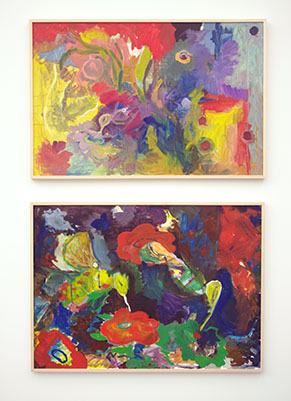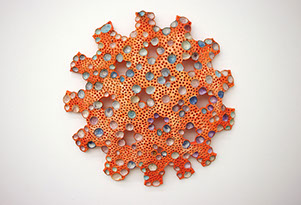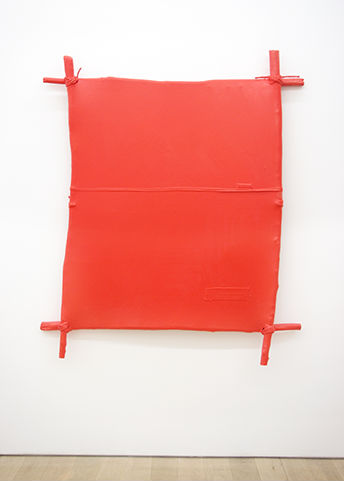





4 - 5
<
>
Review: Anthropocene at CANADA
Around 2000, the term “Anthropocene” emerged in anthropological circles to describe our present epoch: an age characterized by a swelling global population. Homo sapien, under this new rubric, is a geological force as well as a species. The Anthropocene human is also the first to coin its own age and forecast its demise. The former ages of man; Holocene etc., were examined, dissected and theorized retrospectively, but this present age has already begun to archive itself. Projections about ocean levels, global temperature, species decline and food scarcity are often the grim bases for discussion of our species’ future. With the uniformly pessimistic discourse surrounding this new epoch, it is refreshing to see an exhibition who envisions our present-futurity as one which is as absurd as it is colorful.

Adrianne Rubenstein
Pollination 1 (2014) (top) and Pollination 2 (2014) (bottom)
oil on canvas
24 x 36 (top) and 26 x 36 (bottom)
The character of “Anthropocene” is such that chalky, fresco-like color and tragi-comic images of man and woman take form in clay, paint and varieties of assemblage. Many of the objects resemble primitive tools or weapons. For example, consider Al Freeman’s painted tarpaulin and string constructions. Freeman’s work might be prototypes for dual purpose shield-sails in a waterlogged warring world as in the denim blue propped sculpture Tool (Bow) (2014). Oddly, the show paints the present age in J. Crew summer collection colors; salmon, viridian, neutral beige and splashes of a punchy this or that. It’s apt that one is treated to such a breezy spread in these dog-days; the works’ cheeky irreverence is a reprieve from the sardonic murmurs so often associated with the future of our species. Sally Saul’s painted ceramic sculptures
depict hominids as the clunky, feeble apes we really are in Traveling (1998). Standing roughly 1-foot-tall, a furry couple trod through a patch of flowers, the man puts his arm around his bob-haired female companion as both gaze blankly ahead-an image of a modern migrating pair in their natural habitat.
The colors of sinking Venice haunt the show (reminiscent of Sol Lewitt’s Wall Drawing #564). Chris Hood’s Interloper Day Glow (2014) shows a wonky grid of pastel-hued hexagons and quadrilaterals which look like a soft-sculpture version of a tiled floor. Interspersed amongst this field are squiggles and cartoonal creatures (a mushroom, a snail), to suggest some sort of patio in decay. From Hood’s paintings the off-kilter geometry continues in Nicole Cherubini’s four wall-hung clay works. Accented with cracked slabs of terracotta, spray paint and acrylic, Cherubini’s provisional works are like ruined sconces. Where Cherubini gives us self-conscious clunkiness, Elisabeth Kley deftly uses earthenware to its full expressive potential while adhering to its utilitarian history. Her three, roughly 36” tall, free-standing “vases” present exaggerated elongated necks and happy, bulbous bodies. Kley adorns these with floral patterns, scrolls and arabesques which are harried enough to not feel fussy with quickly brushed in swathes of viridian, peach and pea-green glaze. View for example, Large Red and Green Three Part Bottle (2012), with its peach body, large rosettes, leaf forms and simple Grecian geometry.
With its profluence of engaging ceramic and assemblage, “Anthropocene” could have been a very fine sculpture show but the paintings included made the show just pretty good. At the risk of overgeneralization, I will group Adrianne Rubenstein and Alicia Gibson’s work together in the context of this show as little more than chromatic white noise. The former artist presented two liquidy and structureless “abstractions.” The title of Pollination 2 (2014) indicated to me that in the painting,

Joyce Robins
Orange Blue Open Circle (2004)
Clay, glaze, paint
a muddy image of a hummingbird sticks its limp beak into the center of a red puddle. Gibson gives us two solipsistic “feminist” text paintings which, despite an absurd amount of visual information, manage to remain mute.
Joyce Robins’ ceramic discs were surprisingly provocative and unsettling if you, like me, were the victim of that insidious lotus seed pod/skin Photoshop nightmare image (the link read "you will never use Head and Shoulders again"), then these convex disks and clusters were enough to leave your skin squirming. A work such as Pale Oval (2004), a seemingly benign and perfectly lovely sea glass colored objet, might trigger an episode of trichophobia (the fear of holes) for some, while others might delight in its delicate, coral like form. Robbin’s deft transformations of clay straddle the line between domestic finery and alien life form. But then, a little bodily unease was welcome in this land of creaturely delight and magical thinking.

Al Freeman
modern Stone Age (2014)
New Jersey Branches, manilla rope, drop cloth, gesso, oil paint
71 x 60 x 4.5
From the press release:
CANADA is located at 333 Broome Street between Chrystie Street and Bowery. Our summer hours are 11:00 AM to 6:00 PM Tuesday through Friday.
ANTHROPOCENE
July 25 – August 22, 2014
Opening Reception: Friday July 25, 6-8pm
Disclaimer: All views and opinions expressed are those of the authors and do not necessarily reflect the views of the editors, owner, advertisers, other writers or anyone else associated with PAINTING IS DEAD.
